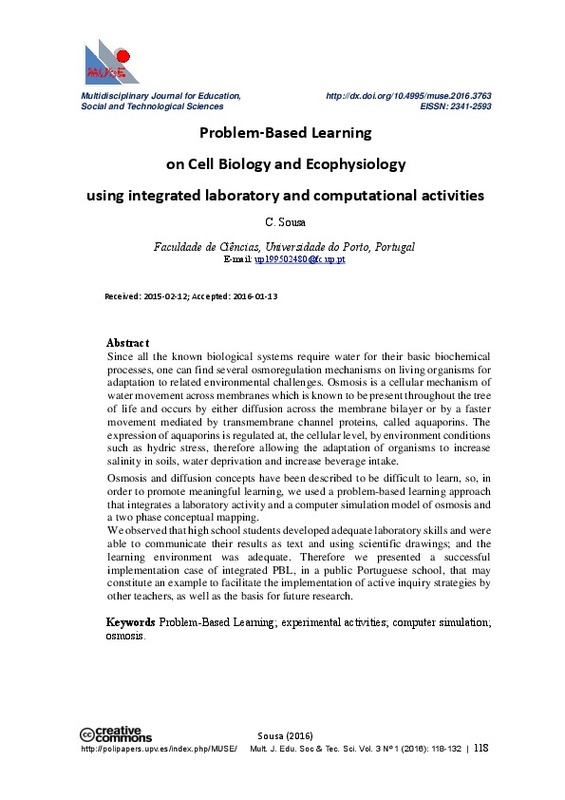JavaScript is disabled for your browser. Some features of this site may not work without it.
Buscar en RiuNet
Listar
Mi cuenta
Estadísticas
Ayuda RiuNet
Admin. UPV
Problem-based learning on cell biology and ecophysiology using integrated laboratory and computational activities
Mostrar el registro sencillo del ítem
Ficheros en el ítem
| dc.contributor.author | Sousa, C.
|
es_ES |
| dc.date.accessioned | 2017-01-17T10:29:20Z | |
| dc.date.available | 2017-01-17T10:29:20Z | |
| dc.date.issued | 2016-03-22 | |
| dc.identifier.uri | http://hdl.handle.net/10251/76914 | |
| dc.description.abstract | [EN] Since all the known biological systems require water for their basic biochemical processes, one can find several osmoregulation mechanisms on living organisms for adaptation to related environmental challenges. Osmosis is a cellular mechanism of water movement across membranes which is known to be present throughout the tree of life and occurs by either diffusion across the membrane bilayer or by a faster movement mediated by transmembrane channel proteins, called aquaporins. The expression of aquaporins is regulated at, the cellular level, by environment conditions such as hydric stress, therefore allowing the adaptation of organisms to increase salinity in soils, water deprivation and increase beverage intake. Osmosis and diffusion concepts have been described to be difficult to learn, so, in order to promote meaningfull learning, we used a problem-based learning approach that integrates a laboratory activity and a computer simulation model of osmosis and a two phase conceptual mapping.We observed that high school students developed adequate laboratory skills and were able to communicate their results as text and using scientific drawings; and the learning environment was adequate. Therefore we presented a successful implementation case of integrated PBL, in a public portuguese school, that may constitute an example to facilitate the implementation of active inquiry strategies by other teachers, as well as the basis for future research. | es_ES |
| dc.description.sponsorship | The author is grateful to the faculty administration for providing funds for this study, and specially to the students that participated in the study, and to the Escola Secundária Aurélia de Sousa (Porto, Portugal) for the conditions to conduct the project. | |
| dc.language | Inglés | es_ES |
| dc.publisher | Universitat Politècnica de València | |
| dc.relation.ispartof | Multidisciplinary Journal for Education, Social and Technological Sciences | |
| dc.rights | Reconocimiento - No comercial - Sin obra derivada (by-nc-nd) | es_ES |
| dc.subject | Problem-Based Learning | es_ES |
| dc.subject | Experimental activities | es_ES |
| dc.subject | Computer simulation | es_ES |
| dc.subject | Osmosis | es_ES |
| dc.title | Problem-based learning on cell biology and ecophysiology using integrated laboratory and computational activities | es_ES |
| dc.type | Artículo | es_ES |
| dc.date.updated | 2017-01-16T13:10:00Z | |
| dc.identifier.doi | 10.4995/muse.2016.3763 | |
| dc.rights.accessRights | Abierto | es_ES |
| dc.description.bibliographicCitation | Sousa, C. (2016). Problem-based learning on cell biology and ecophysiology using integrated laboratory and computational activities. Multidisciplinary Journal for Education, Social and Technological Sciences. 3(1):118-132. https://doi.org/10.4995/muse.2016.3763 | es_ES |
| dc.description.accrualMethod | SWORD | es_ES |
| dc.relation.publisherversion | https://doi.org/10.4995/muse.2016.3763 | es_ES |
| dc.description.upvformatpinicio | 118 | es_ES |
| dc.description.upvformatpfin | 132 | es_ES |
| dc.type.version | info:eu-repo/semantics/publishedVersion | es_ES |
| dc.description.volume | 3 | |
| dc.description.issue | 1 | |
| dc.identifier.eissn | 2341-2593 | |
| dc.contributor.funder | Universidade do Porto |








